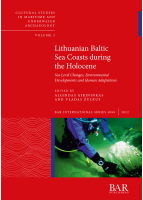Description
Lithuanian Baltic Sea Coasts During the Holocenefocuses on the relicts of the cultural and natural landscapes that survived in the Baltic Sea during the final Paleolithic-Middle Neolithic period in Lithuania. Using a combination of interdisciplinary research methodologies from archaeology, physical and biomedical sciences, with innovative use of underwater technologies, the contributors identify complex underwater landscapes (relic forests, peat bogs, lagoons, paleodelts or palaeo-riverbeds) and cultural objects to determine the evolution of marine paleobasin formation, sea level fluctuations and climate change.
EDITORS
Algirdas Girininkas is Professor of archaeology at the University of Klaipeda, Lithuania. His research interests include material and spiritual culture of the Stone and Bronze Age, economic and social development, and ethnocultural contexts in the Eastern Baltic region. He has published more than ten books on the subject.
Vladas Žulkus is Research Fellow and Professor of archaeology at the University of Klaipeda, Lithuania. He has led underwater archaeological research, including to the flooded landscapes at Baltic Sea. His current research involves the landscape evolution and sea-level changes during the Holocene. He is the author of several papers on the subject.
Contributors: Albertas Bitinas, Jurata Buchovska, Aldona Damušytė, Darius Danusevičius, Linas Daugnora, Nikita Dobrotin, Jolita Petkuvienė, Tomas Rimkus, Miglė Stančikaitė, Sergej Suzdalev, Giedrė Vaikutienė
REVIEWS
'The articles not only report the current state of research in their specific fields, but do so against the background of their new research data. These are based on the most modern, partly innovative methods. The reader is led to the front line of research.' Dr Ulrich Schmölcke, Centre for Baltic and Scandinavian Archaeology (ZBSA)
'The work - both the data and the interdisciplinary approach - is highly original. Much of the data is completely new, especially from underwater contexts. The methods used are cutting edge.' Dr Aki Hakonen, University of Oulu











